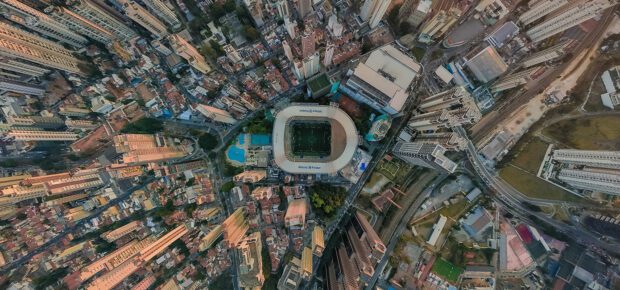November 3, 2022
By 2050, 68% of the world’s population will live in cities. With an additional 2.5 billion people, growing urbanization is putting a strain on outdated infrastructures not created to withstand the sizable populations.
An increase in urbanization means smart cities are on the rise, as communities find ways to use technology to improve the quality of life. That’s also true in Latin America. While currently the region does not lead many global lists of smart cities, it has emerged as a hotspot for smart cities initiatives in emerging economies.
“I see smart cities as a big opportunity to develop new services to improve people’s lives,” said IEEE Senior Member Márcio Teixeira, ”including through the development of smart services for mobility, healthcare, security, water, and energy.”
Known for its densely populated cities, city managers and planners are implementing smart city methods throughout this region that have presented practical tools that city authorities can use to deliver benefits for residents through managing urban growth and decreasing environmental impact.
Opening Doors to Sustainability
Notable smart cities projects in Latin America are already beginning to adopt sustainable methods when developing infrastructure for their cities.
In 2019, residents began moving into the Brazilian city of Laguna, the first affordable smart city of the world. Through integrating multiple smart solutions, including LED lighting, smart irrigation systems, interlocking pavements, urban gardens and solar bricks, Laguna is contributing to creating a community that is leaving less of an impact on the environment.
Santiago, Chile, is home to the largest fleet of electric buses outside of China, with a fleet of 411 battery powered buses, as of June 2020. The roll out of these electric buses has resulted in a decrease in air and noise pollution. These electric buses are not only emission free, but are more cost-effective than conventional diesel buses, costing about 70 percent less to operate. The implementation of these buses in a continued move towards a fully electric public transportation system, is estimated to prevent nearly 1,400 deaths by 2030 based on a United Nations Environment Programme report published in 2017.
A sustainable smart city approach has the potential to increase efficiency, while lowering local air pollution and overall pollution, increase public safety and improve the infrastructure and energy efficiencies for the public.
Implementing an Emphasis on Public Safety
A main pillar for many smart city projects is to improve public safety. Artificial Intelligence and connected IoT devices can assist city officials with implementing systems that better serve to protect citizens. Medellin, Columbia, for example, has an integrated emergency and security System which utilizes information from emergency calls, along with data from video surveillance cameras throughout the city and government agencies, so that emergency services have multiple points of data to respond to emergencies.
Furthermore, Rio de Janeiro’s Smart Rio Project is set to include a program dedicated to modernizing the city’s public lighting systems. Once completed, this project is expected to improve public safety by reducing driving accidents and street crime.
Whether it’s through improved lighting or improving emergency systems, these cities demonstrate the tangible ways that cities throughout the world can make use of smart technology to achieve the goal of creating safer and healthier communities for all.
The Importance of Collaboration
It’s no secret that the development of smart cities requires not only thoughtful planning and investment, but also relies heavily on collaboration. Government officials, private investors, current residents and many others all must work together to see a smart city come to fruition.
The city of Curitiba, Brazil, developed projects including urban farms, innovation hubs and high-capacity sewers. This continued success in the development and execution of these smart projects, is due to its continued collaboration between stakeholders. For one, their Speak Curitiba program allows residents to actively participate in the construction of budget pieces of the municipality.
Furthermore, the city hosts a yearly smart city expo.
“For cities that want to achieve smart city status,” said IEEE Senior Member Euclides Chuma, “it’s critically important for all sectors of society to participate.”
As technology continues to advance and become more interconnected, Latin America is taking advantage of how these innovations will create more sustainable, safer and collaborative communities overall. Through collaborative efforts, city leaders all around the world have the ability to create environments where smart technologies are ingrained within the infrastructure to enhance the quality of life and improve sustainability, safety and economic prosperity for people who live in these regions.
It’s evident that a commitment to come together and foster a culture of innovation, will continue to lead to ongoing success in meeting the challenges and goals of developing smart technology for cities and communities to benefit residents and city members overall.
Learn More: If you want an in-depth look at how a city transforms itself into a smart city, look no further than this webinar from IEEE Smart Cities, which provides an overview of the Smart Cities Master Plan in Salvador, a city in the Brazilian city of Bahia.





 AI Through Our Ages
AI Through Our Ages Liquid Infrastructure: Our Planet's Most Precious Resource
Liquid Infrastructure: Our Planet's Most Precious Resource The Impact of Technology in 2025
The Impact of Technology in 2025 Quantum and AI: Safeguards or Threats to Cybersecurity?
Quantum and AI: Safeguards or Threats to Cybersecurity? Why AI Can't Live Without Us
Why AI Can't Live Without Us Bits, Bytes, Buildings and Bridges: Digital-Driven Infrastructure
Bits, Bytes, Buildings and Bridges: Digital-Driven Infrastructure Impact of Technology in 2024
Impact of Technology in 2024 Emerging AI Cybersecurity Challenges and Solutions
Emerging AI Cybersecurity Challenges and Solutions The Skies are Unlimited
The Skies are Unlimited Smart Cities 2030: How Tech is Reshaping Urbanscapes
Smart Cities 2030: How Tech is Reshaping Urbanscapes Impact of Technology 2023
Impact of Technology 2023 Cybersecurity for Life-Changing Innovations
Cybersecurity for Life-Changing Innovations Smarter Wearables Healthier Life
Smarter Wearables Healthier Life Infrastructure In Motion
Infrastructure In Motion The Impact of Tech in 2022 and Beyond
The Impact of Tech in 2022 and Beyond Cybersecurity, Technology and Protecting Our World
Cybersecurity, Technology and Protecting Our World How Technology Helps us Understand Our Health and Wellness
How Technology Helps us Understand Our Health and Wellness The Resilience of Humanity
The Resilience of Humanity Harnessing and Sustaining our Natural Resources
Harnessing and Sustaining our Natural Resources Creating Healthy Spaces Through Technology
Creating Healthy Spaces Through Technology Exceptional Infrastructure Challenges, Technology and Humanity
Exceptional Infrastructure Challenges, Technology and Humanity The Global Impact of IEEE's 802 Standards
The Global Impact of IEEE's 802 Standards Scenes of our Cyber Lives: The Security Threats and Technology Solutions Protecting Us
Scenes of our Cyber Lives: The Security Threats and Technology Solutions Protecting Us How Millennial Parents are Embracing Health and Wellness Technologies for Their Generation Alpha Kids
How Millennial Parents are Embracing Health and Wellness Technologies for Their Generation Alpha Kids Space Exploration, Technology and Our Lives
Space Exploration, Technology and Our Lives Global Innovation and the Environment
Global Innovation and the Environment How Technology, Privacy and Security are Changing Each Other (And Us)
How Technology, Privacy and Security are Changing Each Other (And Us) Find us in booth 31506, LVCC South Hall 3 and experience the Technology Moon Walk
Find us in booth 31506, LVCC South Hall 3 and experience the Technology Moon Walk Virtual and Mixed Reality
Virtual and Mixed Reality How Robots are Improving our Health
How Robots are Improving our Health IEEE Experts and the Robots They are Teaching
IEEE Experts and the Robots They are Teaching See how millennial parents around the world see AI impacting the lives of their tech-infused offspring
See how millennial parents around the world see AI impacting the lives of their tech-infused offspring Take the journey from farm to table and learn how IoT will help us reach the rising demand for food production
Take the journey from farm to table and learn how IoT will help us reach the rising demand for food production Watch technical experts discuss the latest cyber threats
Watch technical experts discuss the latest cyber threats Explore how researchers, teachers, explorers, healthcare and medical professionals use immersive technologies
Explore how researchers, teachers, explorers, healthcare and medical professionals use immersive technologies Follow the timeline to see how Generation AI will be impacted by technology
Follow the timeline to see how Generation AI will be impacted by technology Learn how your IoT data can be used by experiencing a day in a connected life
Learn how your IoT data can be used by experiencing a day in a connected life Listen to technical experts discuss the biggest security threats today
Listen to technical experts discuss the biggest security threats today See how tech has influenced and evolved with the Games
See how tech has influenced and evolved with the Games Enter our virtual home to explore the IoT (Internet of Things) technologies
Enter our virtual home to explore the IoT (Internet of Things) technologies Explore an interactive map showcasing exciting innovations in robotics
Explore an interactive map showcasing exciting innovations in robotics Interactively explore A.I. in recent Hollywood movies
Interactively explore A.I. in recent Hollywood movies Get immersed in technologies that will improve patients' lives
Get immersed in technologies that will improve patients' lives